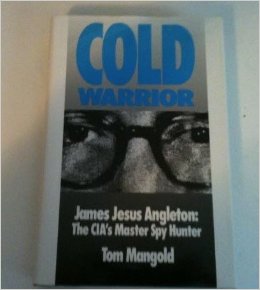Mole Hunting

If, as Sir Winston Churchill said, the Soviet Union is "a riddle wrapped in a mystery inside an enigma," imagine the task of divining what that nation's secret services are up to. For 20 years, from 1954 through 1974, James Jesus Angleton, chief of counterintelligence for the CIA, was entrusted with keeping the evil empire at arm's length, away from our deepest secrets and our own devious agents.
In Angleton's nether world nothing was ever certain. Closest friends may be darkest enemies. Valuable information from a defector may be a loss leader for the subsequent sale of devastating disinformation. Angleton himself characterized Soviet intentions as "a wilderness of mirrors."
Tom Mangold's thesis in "Cold Warrior" is that in the second half of his spy-catching career Angleton became increasingly lost in the wilderness. The book is less a thorough biography (a fact the author concedes) than it is a documentation of Angleton in wonderland. A senior BBC correspondent and author of two previous books, Mangold portrays his subject as a hard-drinking hardliner who built an empire within the CIA complete with its own secret files, rules and agenda.
While the author seems to overstate his case occasionally, the story he tells is generally well documented and believable. His sources include numerous CIA officials -for example, former directors William Colby, James Schlesinger and Richard Helms - as well as Angleton's friends and family. And befitting such a shadowy topic, there are numerous "confidential interviews." If not the last word on Angleton, Mangold's work is clearly the most extensive and critical account of a man who was a legend in Moscow long before he became one in Washington.
This much is not in dispute: James Angleton was born in Idaho in 1917 to an American father and a Mexican mother (hence the middle names Jesus, pronounced in the Spanish fashion). He spent his late teens in Italy, where his father's business was located. Next he attended the prestigious Malvern College in England prior to graduating from Yale in 1941 with "gentleman C" grades. His stints in England, where he was stationed during World War II in the OSS, transformed him into an Anglophile, evident in his dress, speech and fondness for cricket.
He cut his teeth in the CIA in the late 1940s and early 1950s, the heyday of Soviet espionage triumphs. A close friend during this period, Harold "Kim" Philby of the British secret service, would turn out to be a Soviet agent. This betrayal devastated Angleton, both personally and professionally. It is likely that Philby gleaned much from Angleton, among others in the CIA, before coming under suspicion in 1951.
The author maintains that this triumphal Soviet deception contributed mightily to the CIA spymaster's growing paranoia. In 1963, Philby dismissed any remaining doubt by defecting to the Soviet Union. Mangold quotes Newton Miler, an Angleton protege: "Jim talked to me quite a lot about Philby's post-1963 activities. He believed that Kim was maintaining the campaign against Western intelligence from Moscow."
There is no doubt that Angleton felt the Soviets were at least 10 feet tall and capable of the most colossal ruses. He steadfastly believed until he was forced out of the agency in 1974 - if not until his death in 1987 - that the Sino-Soviet split was an international communist trick. Detente was also Soviet sleight of hand.
Of more direct importance to the CIA, its counterintelligence chief became convinced, based on the testimony of Soviet defector Anatoly Golitsyn, that there was a "mole" high up in the agency as well as in the secret services of several allies.
The ensuing search for double agents and suspicions about Soviet defectors during the last decade of Angleton's tenure deeply wounded both the morale and effectiveness of the agency, according to Mangold. Angleton's opponents - including Colby, who would force him to retire - believe the compulsive mole hunting ruined careers and inhibited the recruitment of Soviet assets.
"[Angleton's] staff spent all of their time checking out the backgrounds of potential recruits and not the information they carried," Colby complained. Although this spy trauma has been written about previously, Mangold brings a wealth of sources to bear on the controversy.
In the end, many were suspected, including Angleton himself, but no mole was ever found. Perhaps the Soviets' greatest deception was to convince the CIA for decades - until long after Angleton's departure - that they were 10-feet-tall.